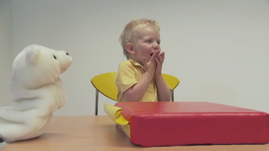Teachers' Domain - Digital Media for the Classroom and Professional Development
User: Preview

Source: The Human Spark: "So Human, So Chimp"




Major funding for The Human Spark is provided by the National Science Foundation, and by the Alfred P. Sloan Foundation. Additional funding is provided by the John Templeton Foundation, the Cheryl and Philip Milstein Family, and The Winston Foundation.
Learning Right and Wrong Transcript
ALAN ALDA: Here’s an experiment I found especially eye-opening. Stefan’s just been shown how to use this toy, and he copies faithfully. Now look what happens when the polar bear puppet does it differently.
MICHAEL TOMASELLO That was exactly what we see, is the kid saying not only did you do it wrong, but here’s the right way to do it.
ALAN ALDA Yeah.
ALAN ALDA (NARRATION) This time Stefan is shown how to push a block in a complex procedure that involves assembling and using a tool.
He’s also told the wrong way to move the block.
Stefan Ah!
ALAN ALDA He’s really into it.
MICHAEL TOMASELLO He’s into it, He’s definitely into it.
ALAN ALDA (NARRATION) Now it’s the polar bear’s turn. Stefan tries to get the bear to do it right, and he tries to stop him from cheating.
This whole notion that there’s a right way and a wrong way to do things, and that children soak up what they’re shown, is a major theme of the Leipzig research. Here, Ingrid has to get the die out of the plastic tube.
MICHAEL TOMASELLO As soon as she sees how to do it it’s easy, but without seeing it she has no idea.
ALAN ALDA And they don’t tend to experiment first?
MICHAEL TOMASELLO They do some but mainly they are waiting and trusting to see how to do it.
ALAN ALDA (NARRATION) But not all experiments go exactly to plan. Again, the task is getting the die. This time Ingrid doesn’t wait to be shown.
ALAN ALDA What do we have here, an Einstein?
MICHAEL TOMASELLO Yeah, exactly. She figured it out without having a model.
ALAN ALDA She went right to that twisting thing.
MICHAEL TOMASELLO That was brilliant.
ALAN ALDA (NARRATION) Now Ingrid is shown the “right” way to do it – the way grown-ups do it.
ALAN ALDA So it turns out that you can make Einstein do whatever you want. No matter how smart Einstein is.
MICHAEL TOMASELLO No matter how smart Einstein is, Einstein will be influenced by watching other people do it, especially if they are older and seemingly more skilled.
 Loading Standards
Loading Standards